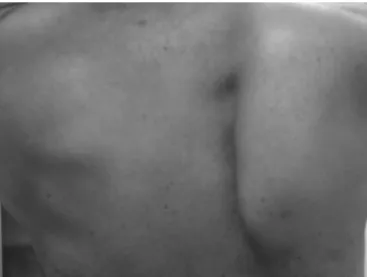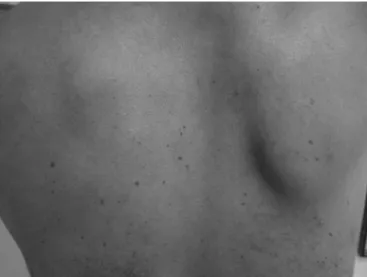w w w . r b o . o r g . b r
Original
Article
Syndrome
of
fascial
incarceration
of
the
long
thoracic
nerve:
winged
scapula
夽
Jefferson
Braga
Silva
a,b,
Samanta
Gerhardt
c,∗,
Ivan
Pacheco
b,daUniversidadeFederaldeSãoPaulo(UNIFESP),SãoPaulo,SP,Brazil
bHospitalSãoLucas,PontifíciaUniversidadeCatólicadoRioGrandedoSul(PUC-RS),PortoAlegre,RS,Brazil
cSchoolofMedicine,PontifíciaUniversidadeCatólicadoRioGrandedoSul(PUC-RS),PortoAlegre,RS,Brazil
dInstituteofSportsMedicine,HospitalMãedeDeus,PortoAlegre,RS,Brazil
a
r
t
i
c
l
e
i
n
f
o
Articlehistory: Received1July2014 Accepted16September2014 Availableonline2September2015
Keywords: Scapula Thorax
Nervecompressionsyndromes
a
b
s
t
r
a
c
t
Objective:Toanalyzetheresultsfromearlyinterventionsurgeryinpatientswiththe syn-dromeoffascialincarcerationofthelongthoracicnerveandconsequentwingedscapula. Methods:Sixpatientswithasyndromeofnervetrappingwithoutspecificnervestrain limi-tationswerefollowedup.
Results:Thepatientsachievedimprovementoftheirsymptoms6–20monthsafterthe pro-cedure.Themotorsymptomscompletelydisappeared,withoutanypersistentpain.The medialdeformityofthewingedscapulaimprovedinallcases,withoutanyresidualesthetic disorders.
Conclusion: Theapproachofearlysurgicalreleaseseemstobeabetterpredictorforrecovery fromnon-traumaticparalysisoftheanteriorserratusmuscle.
©2014SociedadeBrasileiradeOrtopediaeTraumatologia.PublishedbyElsevierEditora Ltda.Allrightsreserved.
Síndrome
do
aprisionamento
fascial
do
nervo
torácico
longo:
escápula
alada
Palavras-chave: Escápula Tórax
Síndromesdecompressãonervosa
r
e
s
u
m
o
Objetivo:Analisarosresultadosdecirurgiadeintervenc¸ãoprecoceempacientescom sín-dromedoaprisionamentofascialdonervotorácicolongoeconsequenteescápulaalada. Métodos:Acompanhamos seis pacientes com uma síndrome de aprisionamento sem restric¸õesespecíficasdeestiramentoaonervo.
Resultados: Pacientestiverammelhoriaemseussintomasseisa20mesesapóso proced-imento.Sintomasmotoresmelhoraramcompletamentesemqualquerdorpersistente.A deformidademedialdaescápulaaladamelhorouemtodososcasossemdistúrbiosestéticos residuais.
夽
WorkdevelopedatHospitalSãoLucas,PontifíciaUniversidadeCatólicadoRioGrandedoSul(PUC-RS),PortoAlegre,RS,Brazil. ∗ Correspondingauthor.
E-mail:samanta.gerhardt@gmail.com(S.Gerhardt). http://dx.doi.org/10.1016/j.rboe.2015.08.011
recuperac¸ãodeparalisianãotraumáticadomúsculoserrátilanterior.
©2014SociedadeBrasileiradeOrtopediaeTraumatologia.PublicadoporElsevier EditoraLtda.Todososdireitosreservados.
Introduction
Wingedscapulaisanuncommonconditionthataffectsthe scapulothoracicstabilizermuscles that causeseparation of thescapulafromtheribcage.1 Theanteriorserratus,which
isinnervatedbythelongthoracicnerve,isinvolvedin abduc-tionandelevationoftheshoulderandattachesthescapula totheribcage.Anytypeofstrainorforceonthisnervemay resultinparalysisofthemuscle.2,3Insituationswithoutsigns
oftraumaorforce,theetiologymaybeinsidiousand compres-sive,causedbythemuscleitselfanditssuperficialfascia.4,5
Theclinicalhistoryandphysicalexaminationareareliable basisforthediagnosis,althoughelectromyographycanalso demonstratetheimpactonthenerve.1,6 Thepresentarticle
focusesonoccurrencesofwingedscapuladuetoparalysisof theanteriorserratus,withsecondaryconsiderationgivento thecompressionsyndromeofthelongthoracicnerve.
Inourcaseseries,wepresentasyndromeofincarceration withoutanyspecificrestrictionsduetonervestrain.Our inten-tionwastoanalyzeearlysurgicalintervention,whichconsists offullrelease ofthefasciathatcompressestheentirepath ofthelong thoracicnerve,performedwithinsixmonthsof theappearanceofthe initialsymptoms,eventhoughsome authorshaverecommendedconservativetreatmentforthis condition.3 Throughthis approach,webelievethatthe risk
ofdevelopingsequelaeisdiminished,whichthereforeallows patientstoreturntotheirroutinemorerapidly.
Methods
Sixpatientswerechosenthroughtheinclusioncriteria, i.e. thosewhopresentedasyndromeoffascialincarceration with-out any specific restrictions of nerve strain were used as controls.Traumaticeventswerenotassociatedwiththisand otheretiologiesofeffortwerediscarded.Allthecasesinthis seriespresentedatleastthreemonthsofsymptoms consis-tentwithpain,acertaindegreeofdeficiencyoftheshoulder and paralysis of the anterior serratus alone induced by a wingedscapula. Nocomorbiditiesand norelevant medical findingswere recorded inanyofthecasesand acomplete examinationoftheshoulderwasperformedineachcase.
Noneofthepatientswereabletodetermineexactlywhen theirsymptomshadstartedandnoneofthemreportedhaving sufferedanytypeoftraumaorphysicalstressrelatingtotheir condition.Surgicaltreatmentwasconsideredsixmonthsafter thestartofthesymptomsineachcase.
Anapproachinvolvingamedialaxillaryincisionwasused inallthecasestoidentifythelongthoracicnerveandrelease itfromitscoursealongtheanteriorserratusmuscle,between thesuperficialfasciaandthedigitationsofthemuscle.The
meanlengthoffollow-upwas24months,witharangefrom 18to32.Thepatients’meanagewas28years,witharange from16to34.Therewerefourfemalepatientsandtwomale patients. Four patients madea livingdoing work withlow manualimpact,whiletheothertwowereadolescentswithout any athletic activities. Onlytwo ofthe six patients under-wentelectromyography,whichwehadnotindicated,sincewe believethatthediagnosiscanbemadepurelyfromtheclinical examinationfindings.
Results
Inallthecases,thepatient’sdominantsidewascompromised. Allthepatientspresentpainandacertaindegreeoflimitation ofthescapularbelt,whichwasexacerbatedthroughfrontal elevationandabduction.Allofthempresentedscapular defor-mationthatdistressedthemesthetically(Figs.1and3).
Thelongthoracicnervewasfoundtobecurrentlyinits usual position. Nospecificcompressive sitewas identified. Thus,noischemicalterationwasnotedinanyspecific por-tionofthenerve.Neurolysiswasperformedalongtheentire courseofthenerve,fromproximaltodistalandoveritstop surface,whichreleasedthefascialcompressionoverthe mus-cle,therebycarefullypreservingtheintermuscular andend branches.
Thepatientspresentedimprovementsintheirsymptoms 6–12 monthsafterthe procedure. Thelength ofthe recov-eryperiodrangedfrom6to12months.Themotorsymptoms improvedcompletely,withoutanyprolongedpain.Themedial scapular deformity improved inall the cases, without any residualestheticdisorders(Figs.1–5).
Fig.1–Case1,beforetheoperation.Unstablewinged
Fig.2–Case1,ninemonthsaftertheoperationwith
stabilizationofthescapula.
Fig.3–Case2,beforetheoperation.Wingedscapulaof
idiopathicorigin.
Fig.4–Case2,twomonthsaftertheoperation.
Fig.5– Case2,ninemonthsaftertheoperation.
Nocomplicationsoccurredduringthe procedureorasa consequenceofit,andnorecurrenceshavebeendocumented uptothepresentdate.Theincisionscarsevolvedinanormal manner,withoutadherencesorrestrictions.
Discussion
Wingedscapulaisanuncommonconditionthatitlittle diag-nosed.Itisoftencausedbydysfunctionofthescapulothoracic stabilizer muscles, i.e.the anterior serratus, trapezius and rhomboidmuscles.Impairmentofthelongthoracicand acces-soryspinalnervesisthecommonestcauseofwingedscapula, whileseveraletiologies involvingthe integrityofthe nerve havealsobeendiscovered.1
The anterior serratus muscle has three portions and is insertedinthemedialportionofthescapula.Itisprimarily innervatedbythelongthoracicnerve,whichcharacteristically arisesfromthreerootsbetweenthefifth,sixthandseventh cervicalnerves(C5–C7).2
Inananatomicalstudyoncadavers,Hamadaetal.7
metic-ulouslydemonstratedtheinnervation,insertionandfunction oftheanteriorserratus.Theupperpartisinnervatedmainly bytherootofC5andmayreceivebranchesfromC4,C6andC7, whilethemiddleandlowerpartsareinnervatedbytheroots ofC6andC7.Thespecificfunctionsofthepartsofthismuscle arestabilization,abductionandupwardrotation,respectively. Becausethe nerve runssuperficiallytothe muscle, this makes it vulnerable to any type of trauma. Thus, winged scapula due to paralysis of the anterior serratus alone is alwaysmedialandlengtheningthemusclemakesitpossible toseparatethescapulafromtheribcage.5,8
Otherconditionsthatcausewingedscapulainclude paral-ysisofthetrapeziusandrhomboidmuscle,andtheseinvolve theaccessorynerveanddorsalscapularnerve,respectively. Theseparalyzesresultinalateralwingedscapula,whichthus differsfromparalysisoftheanteriorserratusalone.1,3,9,10
Inrelationtothephysiopathology,contusivetraumathat producesneuropraxiaisreportedinthemajorityofthecases inwhichparalysisoftheanteriorserratusoccurs.Otherforms oftraumamaybecausedbyrepetitivemovements,suchas thosethatarecommoninmanuallaboractivitiesordomestic activities.4
Othercommoncausesoftraumaticaggressiontonerves includeinvasiveproceduressuchasmastectomywith resec-tionofaxillarynodules,thoracostomy,useofaxillarycrutches anduse ofchiropractic.Thenon-traumaticetiologies asso-ciated withparalysis ofthe anterior serratus includeviral diseases, poisoning, muscular dystrophy and mechanical injuriessuchasprolongedabductionofthearmwhenlying downorcertainpositionsrelatingtoanesthesia.12
Compressive complaints inmuscle structuresalongside proximalnervesegmentshavebeenwelldocumented,given thatthenerveperforatesthescalenemuscle.However,this indicatorofthecauseisnotveryreliable,giventhatthedorsal scapularnervealsoperforatesthescalenewithoutaffecting therhomboid.Ascapularbursaorenlargedandinflamed sub-coracoidmayalsocausenervecompression.3,13,14
Hesteret al.13proposed aninternalmechanicaletiology
that involvesthe forces created byabduction and external rotationofthearm,whichcausesthelongthoracicnerveto extendlikeanarcharoundtheextendedfasciabetweenthe plexus,scalenemuscleandfirstrib.Thistheoryarosefroma studyonasmallnumberofcadavers.
Thedifferent physiopathological mechanisms that have beendescribedexplaintheprogressiveconstrictiveeffectof thefasciaoftheanteriorserratusbythethoracodorsalnerve. Thesecanbeconsideredtobeconstrictiverepetitiveinjuries ordysfunctionthrough exertion,thereby causinga defined syndrome.Activecontractilityofthefascia,alongwith over-lapping of the nerve, may help in explaining the altered dynamicsofthe muscle.Thistheory may explainhowthe fascia would contract in a smoothmuscle-like mannerso astoproduceaconstrictiveeffect.Themyofascialtonusat restmaybeanotherfactorinvolvedinthe physiopathologi-calexplanationofthesyndrome.Independentoftheactivity of the central nervous system, passive muscle tension at rest is transmitted in a complex manner to the fibrils of thematrix ofthesurrounding fasciaand tothe connective tissue.15–18
Itneedsto beunderstood that awinged scapulais not simplyan estheticproblem,given thatthe muscle activity requiredinordertocompensateforthestabilityofthe shoul-derisassociatedwithsecondarypainandspasmscausedby muscle imbalance and irritationof the tendonaround the shoulderjoint.3,19
Electromyographyisausefultoolforattemptingtoidentify theetiologiesofdifferentperipheralneurologicalconditions, includingcompressivesyndromes.
Paralysisoftheanteriorserratusisaspecificentitythatis capableofproducingawingedscapulaofmedialappearance, inwhichallthemuscleinsertionsarepresent.20
Asmentionedearlier,noneofthepatientstreatedhadany historyoftraumaorrepetitivephysicalstressonthelateral partofthechest,whichaddeddifficultytoidentifythe etiol-ogy.Manystudieshaveproposeddifferentpointsatwhichthe nervemightbetrappedbetweendifferentstructures,suchas
thescalenemuscleorrootsofthethoracodorsalartery,with fascialstrainandmuscleabnormalities.4,7,13,21
Inourcaseseries,noparticularstructuresotherthanthe fasciaitselfwereinvolvedincompressionofthelongthoracic nervealongitsentirecourse.Laulanetal.2proposeddifferent
etiologies,suchasoverlappingoftherootsofthe thoracodor-salarteryontothedistalnerve.
Themainetiologicalfactorsandmechanismsinvolvedin paralysisoftheanteriorserratusaloneweredescribedwellby VastamakiandKauppila.9Moreover,inastudyoncadavers,
Kauppila4demonstratedtheimplicationsofscapular
abduc-tion movement onstretchingofthe lowersegments ofthe nerve andarteriesthatsupplythe lowerdigitations,where thesesegmentsseemtobelooser.Thisauthoralsosuggested thattheremightbeadeficiencyofbloodsupplyinthe sub-scapular artery, which would affect this inferior epineural segmentviathelowerangleofthescapula.
Hesteretal.13identifiedfascialstrainbetweenthelower
aspect ofthebrachial plexusand theupperportion ofthe muscle,whichwouldhavethecapacitytocompressthenerve duringabductionandexternalrotationofthearm.
Several studies have recommended that non-surgical methodsshouldbeusedtoresolvecasesofwingedscapula causedbyforceonthenerve,repetitivetrauma(suchasfrom activitiesrelatingtosports)oraccidents.However,other stud-ieshaveshownthatthereisasignificantimprovementrate throughsurgeryperformedatearlystagesofthesymptoms. Itisknownthatonlyafewofthesepatientswillrecover spon-taneously.Somemayshowpartialimprovementormayeven notimprove,thuscontinuingtopresentdebilitatingsequelae. Thismaybeadecisiveargumentforproposingsurgeryduring theearlystages.2,14
All the patients in our case series underwent surgical releasesixmonthsafterthesymptomsstarted,giventhatwe stronglysuspectednerveincarcerationonthebasisofthe clin-icalfindings,amongwhichtherewasnohistoryoftraumaor force.
Thedifferentsurgicalmethodsattempttoreestablishthe physiologicalmechanicsofthescapularbelt,giventhat defini-tivesequelaearepresent.Muscletransfers,especiallyusing flaps from the pectoralis major, and also scapulothoracic arthrodesis,wereusefulforobtainingpartialimprovements. Novak and Mackinnon22 presenteda single case in which
transferofthethoracodorsalnervetothelongthoracicnerve resultedingoodfunctionalrecoveryoftheanteriorserratus muscle.19,23
Conclusions
Even though our case series involved a small number of patients,itcouldbedemonstratedthattheoriginof incarcera-tionofthelongthoracicnervewaspurelyfascial,andthatthis inducedacompletesyndrome.Earlysurgicalreleaseseemsto beagoodpredictorforrecoveryfromnon-traumaticparalysis oftheanteriorserratus.
releaseofthenerve,notmorethansixmonthsafterthestart ofthesymptoms.
Paralysisoftheanteriorserratusisawell-recognizedform ofparalysis thatarisesfrom amedialwinged scapula.Itis causedbyelongationoftheinsertionofthreeportionsofthe muscleatthemedialborderofthescapula.Theclinical his-toryandexaminationprovidesufficientbasisformakingthe diagnosisandplanningsurgicaltreatmentinallcases.
Thesyndromeoffascialincarcerationseemstobeaspecific entitythatinvolvesmyofascialdynamicsandtension,andit leadstoaviciouscircleinwhichmicrovascularinsufficiency, fascialfibrosis,frictionandrestrictionsonslidingperpetuate theconstriction,asisseeninothertypesofcompressive neu-ropathyoftheupperlimbs.Studiestakingintoconsideration themyofascialphysiologicalmechanicsandtheirrelationship withthelongthoracicnerveneedtobeconducted.
Conflicts
of
interest
Theauthorsdeclarenoconflictsofinterest.
r
e
f
e
r
e
n
c
e
s
1. GhoshPS,HsichGE.Scapularwinging.JPediatr.2012;160(1): 169–70.
2. LaulanJ,LascarT,Saint-CastY,ChammasM,LeNenD. Isolatedparalysisoftheserratusanteriormusclesuccessfully treatedbysurgicalreleaseofthedistalportionofthelong thoracicnerve.ChirMain.2011;30(2):90–6.
3. MeiningerAK,FiguerresBF,GoldbergBA.Scapularwinging: anupdate.JAmAcadOrthopSurg.2011;19(8):453–62. 4. KauppilaLI.Thelongthoracicnerve:possiblemechanismsof
injurybasedonautopsystudy.JShoulderElbowSurg. 1993;2(5):244–8.
5. SegondsJM,AlnotJY,AsfazadourianH.Isolatedtraumatic serratusanteriormusclepalsy.RevChirOrthopReparatrice ApparMot.2002;88(8):751–9.
6. TsivgoulisG,VadikoliasK,CourcoutsakisN,HeliopoulosI, StamboulisE,PiperidouC.Teachingneuroimages:differential diagnosisofscapularwinging.Neurology.2012;78(17):e109. 7. HamadaJ,IgarashiE,AkitaK,MochizukiT.Acadavericstudy
oftheserratusanteriormuscleandthelongthoracicnerve.J ShoulderElbowSurg.2008;17(5):790–4.
8.FooCL,SwannM.Isolatedparalysisoftheserratusanterior.A reportof20cases.JBoneJointSurgBr.1983;65(5):
552–6.
9.VastamakiM,KauppilaLI.Etiologicfactorsinisolated paralysisoftheserratusanteriormuscle:areportof197 cases.JShoulderElbowSurg.1993;2(5):240–3.
10.CoroL,AzuelosA,AlexandreA.Suprascapularnerve entrapment.ActaNeurochirSuppl.2005;92:33–4.
11.WiaterJM,FlatowEL.Longthoracicnerveinjury.ClinOrthop RelatRes.1999;(368):17–27.
12.PaluzziA,WoonK,BodkinP,RobertsonIJ.‘Scapulaalata’asa consequenceofparkbenchpositionforaretro-mastoid craniectomy.BrJNeurosurg.2007;21(5):522–4.
13.HesterP,CabornDN,NylandJ.Causeoflongthoracicnerve palsy:apossibledynamicfascialslingcause.JShoulder ElbowSurg.2000;9(1):31–5.
14.DisaJJ,WangB,DellonAL.Correctionofscapularwingingby supraclavicularneurolysisofthelongthoracicnerve.J ReconstrMicrosurg.2001;17(2):79–84.
15.MasiAT,HannonJC.Humanrestingmuscletone(HRMT): narrativeintroductionandmodernconcepts.JBodywMov Ther.2008;12(4):320–32.
16.LevinSM.Humanrestingmuscletone(HRMT):narrative, introduction,andmodernconcepts.JBodywMovTher. 2009;13(2):117–8.
17.WheelerAH.Myofascialpaindisorders:theorytotherapy. Drugs.2004;64(1):45–62.
18.SchleipR,KlinglerW,Lehmann-HornF.Activefascial contractility:fasciamaybeabletocontractinasmooth muscle-likemannerandtherebyinfluencemusculoskeletal dynamics.MedHypotheses.2005;65(2):273–7.
19.KiblerWB,SciasciaA,WilkesT.Scapulardyskinesisandits relationtoshoulderinjury.JAmAcadOrthopSurg. 2012;20(6):364–72.
20.KaplanPE.Electrodiagnosticconfirmationoflongthoracic nervepalsy.JNeurolNeurosurgPsychiatry.1980;43(1): 50–2.
21.EbraheimNA,LuJ,PorshinskyB,HeckBE,YeastingRA. Vulnerabilityoflongthoracicnerve:ananatomicstudy.J ShoulderElbowSurg.1998;7(5):458–61.
22.NovakCB,MackinnonSE.Surgicaltreatmentofalong thoracicnervepalsy.AnnThoracSurg.2002;73(5):1643–5. 23.UerpairojkitC,LeechavengvongsS,WitoonchartK,

